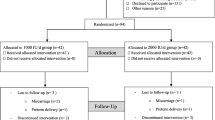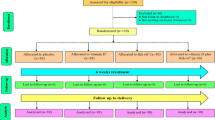Abstract
Iron overload could promote the generation of free radicals and result in deleterious cellular damages. A physiological increase of oxidative stress has been observed in pregnancy. A routine iron supplement, especially a combined iron and vitamin C supplementation, without biological justifications (low hemoglobin [Hb] and iron stores) could therefore aggravate this oxidative risk. We investigated the effect of a daily combined iron supplementation (100 mg/d as fumarate) and vitamin C (500 mg/d as ascorbate) for the third trimester of pregnancy on lipid peroxidation (plasma TBARS), antioxidant micronutriments (Zn, Se, retinol, vitaminE, (β-carotene) and antioxidant metalloenzymes (RBC Cu-Zn SOD and Se-GPX). The iron-supplemented group (n=27) was compared to a control group (n=27), age and number of pregnancies matched. At delivery, all the women exhibited normal Hb and ferritin values. In the supplemented group, plasma iron level was higher than in the control group (26.90±5.52 mmol/L) and TBARs plasma levels were significantly enhanced (p<0.05) (3.62±0.36 vs 3.01±0.37 mmol/L). No significant changes were observed in plasma trace elements and red blood cell antioxidant metalloenzymes. Furthermore, the α-tocopherol plasma level was lowered in the iron-supplemented groups, suggesting an increased utilization of vitamin E.
These data show that pharmalogical doses of iron, associated with high vitamin C intakes, can result in uncontrolled lipid peroxidation. This is predictive of adverse effects for the mother and the fetus. This study illustrates the potential harmful effects of iron supplementation when prescribed only on the assumption of anemia and not on the bases of biological criteria.
Similar content being viewed by others
References
US Preventive Services Task Force. Routine iron supplementation during pregnancy. Police Statement. JAMA 270, 2846–2854 (1993).
H. Lindsay and A. Allen, Pregnancy and iron deficiencies, Nutr. Rev. 55, 91–101 (1997).
R. Goldenberg, T. Tamura, T. M. Dubard, K. E. Johnson, R. L. Kopper, and Y. Neggers, Plasma ferritin and pregnancy outcome, Am. J. Obstet. Gynecol. 175, 1356–1359 (1996).
M. Thame, R. J. Wilks, A. Mc Farlane, F. I. Benette, and T. E. Forrester, Relationship between maternal nutritional status and weight and body proportions at birth. Eur. J. Clin. Nutr. 51, 134–138 (1997).
L. Dai, P. G. Wynyard, Z. Zhang, D. Rake, and C. J. Morris. Ascorbate promotes low-density oxidation in the presence of ferritin. Biochem. Biophys. Acta. 1304, 223–228 (1996).
J. M. Gutteridge, Iron promoters of the Fenton reaction and lipid peroxidation can be released from heamoglobin by peroxides. FEBS Lett. 201, 291–95 (1986).
B. Halliwell and J. M. Gutteridge, Role of free radicals and catalytic metal ions, in Human Disease: An Overview, L. Packer, and A. N. Glazer eds. Methods in Enzymology Vol. 186, San Diego Academic Press; pp.1–85 (1990).
Y. Takehara, T. Yoshioka, and J. Sasaki, Changes in the levels of lipoperoxides and antioxidant factors in human placenta during pregnancy. Acta Med. 44, 103–107 (1990).
A. A. Cargnoni, G. Gregorini, C. Ceconi, R. Maiorca, and R. Ferrari. Lipid peroxidation in normal pregnancy and preeclampsia, Adv. Exp. Med. Biol. 366, 420–423 (1994).
J. Arnaud, J. Bellanger, P. Chappuis, and A. E. Favier, Recommended method for assaying serum zinc with flame atomic absorption. Ann. Biol. Clin. 44, 77–87 (1986).
J. Arnaud, J. Bellanger, P. Chappuis, A. E. Favier, and M. Galliot, Recommendations for the assay of serum copper by flame atomic absorption spectrometry, Ann. Biol. Clin. 43, 297–318 (1985).
J. Arnaud, J. I. Fortis, S. Blachier, D. Kia, and A. E. Favier, Simultaneous determination of retinol, α-tocopherol and β-carotene in serum by isocratic high performance liquid chromatography, J. Chromatogr. 572, 103–16 (1991).
M. J. Richard, B. Portal, J. Meo, C. Coudray, A. Hadjian, and A. E. Favier, Malondialdehyde kit evaluated for determining plasma and lipoprotein fractions that react with thiobarbituric acid, Clin. Chem. 38, 704–09 (1992).
S. Marklund and G. Marklund, Involvment of superoxide anion radical in the autoxidation of pyrogallol and a convenient assay for superoxide dismutase, Eur. J. Biochem. 74, 469–474 (1974).
W. A. Gunzler, H. Kremers, and L. Flohe. An improved test procedure for glutathione peroxidase in blood, Z. Klin. Chem. Klin. Biochem. 12, 444–448 (1974).
F. R. Hurrell, Preventing iron deficiency through food fortification, Nutr. Rev., 55 (6), 210–222 (1997).
T. Chepda, C. Perier, A. Chamson, and J. Frey, Effets pro-et antioxidants de l’ascorbate, Nutr. Clin. Metabol. 13, 115–120 (1999).
R. Almaas, T. Rootwelt, S. Oyasaeter, and O. D. Saugstad, ascorbic acid enhances hydroxyl radical formation in iron-fortified infant cereals and infant formulas, Eur. J. Pediatr., 156, 488–492 (1997).
J. L. Sullivan, Antioxidant effects of iron depletion, Free Radic. Biol. Med. 17, 87–92 (1977).
O. J. Aruoma, M. J. Halliwell, M. J. Laughton, J. G. Guinlan, and J. M. Gutteridge, The mechanism of initiation of lipid peroxidation. Evidence against a requirement for an iron (II)–iron(III) complex. J. Biochem. 258, 617–620 (1989).
T. T. Lao, K. Tam, and L. Y. Chan, Third trimester iron status and pregnancy outcome in non-anemic women; pregnancy unfavourably affected iron excess, Hum. Reprod. 15 (8), 1843–1848 (2000).
J. L. Sullivan, The iron paradigm of ischaemic heart disease. Am. Heart. J. 117, 1177–1188 (1989).
A. J. Sinclair, A. H. Barnett, and J. Lunec, Free radicals and antioxidant systems in health and disease, Br. J. Hosp. Med. 43, 334–344 (1990).
J. Bates, S. Young, L. Galway, A. Traub, A. Hadden, Antioxidant status and lipid peroxidation in diabetic pregnancy, British J. Nutr. 78, 523–532 (1997).
Y. Wang, S. W. Walsh, J. Guo, and J. Zhang, The imbalance between thromboxane and prostacyclin in preeclampsia is associated with an imbalance between lipid peroxides and vitamin E in maternal blood. Am. J. Obstet. Gynecol. 165, 1695–1700 (1991).
J. T. Uotila, R. J. Tuimala, T. M. Aamio, K. A. Pykko, and M. Ahotipa, Findings on lipid peroxidation and antioxidant function in hypertensive complications of pergnancy, Br J. Obstet Gynecol, 100, 270–276 (1993).
S. K. Jain and T. Wise, Relationship between elevated lipid peroxides, vitamin E deficiency and hypertension in preeclampsia, Mol. Cell. Biochem. 1, 33–38 (1995).
Y. Wang, S. W. Walsh, J. Guo, and J. Zhang, Maternal levels of prostacyclin, thromboxane, vitamin E, and lipid peroxides throughout normal pregnancy, Am. J. Obstet. Gynecol. 165, 1690–1694 (1991).
B. Lachili, A. M. Roussel, J. Arnaud, M. J. Richard, C. Benlatrèche, and A. E. Favier, Plasma antioxidant trace element levels and related metalloenzymes in Algerian women. In: J. Neve, P. Chappuis, M. Lamand, A. E. Favier, eds., Therapeutic Uses of Trace Elements, Plenum Press, New York, pp. 203–207 12, (1996).
Author information
Authors and Affiliations
Rights and permissions
About this article
Cite this article
Lachili, B., Hininger, I., Faure, H. et al. Increased lipid peroxidation in pregnant women after iron and vitamin C supplementation. Biol Trace Elem Res 83, 103–110 (2001). https://doi.org/10.1385/BTER:83:2:103
Received:
Revised:
Accepted:
Issue Date:
DOI: https://doi.org/10.1385/BTER:83:2:103




